|
FAQs about Stony Coral Health/Disease/Pests:
Treatments
Related Articles: Coral Pests and Disease; pests, predators,
diseases and conditions by Sara Mavinkurve,
Quarantine of Corals
and Invertebrates, LPS
Corals, True or Stony Corals, Order
Scleractinia, Propagation for Marine
Aquarium Use,
Related FAQs: Stony Coral Disease 1, Stony Coral Disease 2, Stony Coral Disease 3, Stony Coral Disease 4, Stony Coral Disease 5, Stony Coral Disease 6, Stony Coral Disease 7, Stony Coral Disease 8, Stony Coral Disease 9, Stony Coral Disease 10,
Stony Coral Disease 11, Stony Coral Disease
12, Stony Coral Disease 13,
Stony Coral Disease 14,
FAQs on Stony Coral Disease by Category: Diagnosing:
Environmental (Pollution/Poisoning, Lighting...),
Nutritional, Social (Allelopathy),
Trauma,
Pathogenic (Infectious, Parasitic, Viral)
Predatory/Pest,
FAQs on Stony Coral Disease by Family: Acroporid Disease, Acroporid Disease 2, Acroporid Disease 3, Acroporid Disease 4..., Caryophyllid Disease, Caryophyllid Disease 2..., Elegance Coral Disease/Pests, Dendrophylliid Disease, Faviid Disease, Faviid Disease 2, Fungiid Disease, Mussid Disease, Mussid Health 2, Poritid Health, Trachyphylliid Disease, Trachyphyllia Disease 2,
FAQs on Stony Coral Disease by Type: Brown Jelly Disease, RTN,
|
|
|
Problems with online ordered corals
4/10/15
Hello All,
<Vinh>
I hope that everything is well on your side.
<Yes; thank you>
I recently made my first attempt at ordering corals online, and they took bit
longer than anticipated to arrive, about a 24 hour transit because of delays.
<Not atypical; plus who knows how much time in the bag>
I finally received several specimens, but I noticed some problems with some of
the corals that were shipped almost right away. This is how they had arrived.
The torch coral has one dead head.
<See this>
One of the LPS has significant tissue damage, not sure what the cause is.
Another LPS has bleached spots.
My Acropora carduus is bleaching on the tips.
<And all of these>
To try and contain the spread of the damage, should I cut off the parts that are
affected?
<I wouldn't do this... not just yet... Instead the iodide and simple sugar/s
treatment gone over on WWM>
Will this help?
<Not likely.... right now... more probable to cause further stress, troubles>
I've attached some photos for your consideration. I used the recommended
acclimation method from WetWebMedia
as well and they are currently in a quarantine system.
<Ah good.... again, iodide-ate and hexose carbohydrate; perhaps dropping the
spg. a thousandth to induce uptake>
Please let me know what your recommendations are.
<As stated. Bob Fenner> |
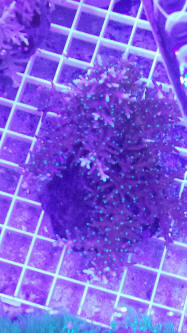
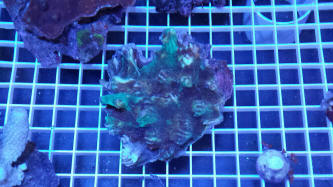
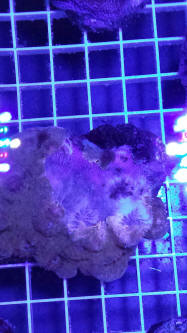
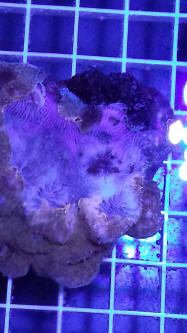 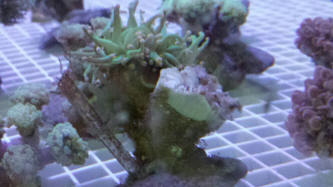 |
Re: Problems with online ordered corals
4/10/15
Hello Bob,
Thank you for your kind reply. I'm terribly sorry but I've done a search on
your website, as well as on Google, but I can't seem to find the article
regarding the directions for performing this treatment.
<Mmm; try the search tool at the top of every page: "Corals Iodine", "Corals
Sugar", then the second search tray to the right w/ just the Iodine or Sugar
word in it. Oh! Tried out myself... some here:
http://www.wetwebmedia.com/iodf2.htm >
I've read through many pages of your FAQs today that have suggestions to add
iodide and a simple sugar, but I was hoping that you had a page with
directions?
<Mmm; not as far as I'm aware>
Would this treatment be performed as a dip?
<Best on the way in from the source. These mat.s are part of my S.O.P. for
the wholesale and collecting sides of the trade>
If you would be able to point me to the right page, (maybe I'm performing
the wrong search) that would be very much appreciated.
<Welcome. BobF>
Re: Problems with online ordered corals
4/11/15
Hello Bob,
<Vinh>
Thanks for sending me the link so much, you and your crew are so dependable and
your advice is always appreciated. I've gone through the page, but I do have two
questions if you don't mind.
1. I acclimated the corals on late Weds. night so they haven't been in the
system for more than 48 hours yet. When should I perform this treatment?
<ASAP>
Right away or wait until the corals settle in a little more.
<Now>
2. How often should I perform this as I read on WWM, that moving the corals 3-4x
per week will surely kill them.
<Doesn't help them to be moved for sure; esp. if not stabilized/healthy.
See the Stony Coral Health FAQs on WWM for much more. Bob Fenner>
Re: Problems with online ordered corals 4/11/15
Also I picked up SeaChem Iodide and glucose from the grocery store like you had
suggested.
<Ah good. You'll be able to see "results" in a few hours.... really. BobF>
|
Re: Problems with online
ordered corals
4/13/15
<Vinh; pls reduce your image file sizes by an order of magnitude and re-send
all>
Re: Problems with online ordered corals
4/13/15
Here you go.
Please let me know if this is better.
<Is; but see our limits re... in "how to write us">
Hello Bob,
I was able to stop some of the RTN on the corals with the treatment
suggested, but some of the corals have gotten worse unfortunately.
I do have a couple more issues with my most recent online shipment that I
would like your advice on.
Here are my parameters
Calcium 460
Magnesium went from 1280 to 1080 after I added the corals Alk 9.8
Salinity
1.23
<likely 1.023; needs to be NSW strength: 1.025-6>
Temp: 76.5
Phosphate: 0
Nitrate: 0
<Chemically starved.... Trouble: ALL life needs some/measurable NO3 and
HPO4... SEE WWM re>
I have a couple of Montipora danaes, are they suffering from brown jelly
disease?
<Maybe>
One of my LPS, the tissue has deteriorated on a part of it, should I perform
the same iodide/glucose treatment?
<Yes; on import; in the process of receiving, acclimation>
I've attached a photo of when I received
it and how it looks now. The photo of when I received it isn't as clear.
For the past treatment, I used my tank water in a 4.5G kitty litter tray.
I
used glucose syrup, since they didn't have it in powder form. As for the
Iodide, it said that 2 drop per 20G tank will increase by .1. My level were
at .6 and I was trying to get to the 5.1 that I had read on one of your
feedbacks, but that was for the for Lugol's treatment though. I used a
squirt which was about 55ML. Does that sound about correct?
<Yes>
Finally, two of the Acros at this point with the bleaching, it seems
to have
some algae taking over.
<Bad>
Should I consider this a loss battle and get him
out of the quarantine so it doesn't do further damage to the other corals?
<Mmm; I'd leave in place and hope for the best. Acroporids are way down on
the scale of "allelopathy">
As always thanks for your input.
<Again; all need to develop and adhere to a strict protocol, S.O.P., in
engaging in importing these animals.
Bob Fenner>
|
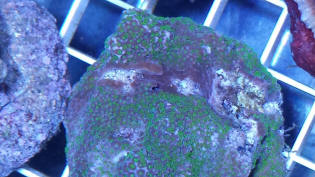
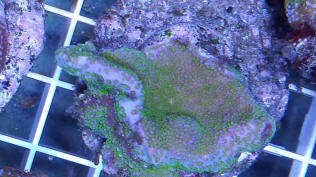  |
|
Quarantine and Dipping
of Acropora 7/14/05 Hi, I have read recommendations to dip all new
Acroporas in ReefDip, FlatwormExit and Lugol's (I
presume separately?). <...> We have several frags in
quarantine for 4 weeks prior to entry into the tank (for ich as well as
other parasites). During that time, I have examined them
every few days with a magnifying glass and don't see any bugs at
all (and the color looks very good). A few of the frags have
harmless commensal crabs (smooth shells). I hate to hurt the
crabs by doing a dip and don't want to add unnecessary stress to
the corals. If examined regularly for 4 weeks and nothing
looks out of the ordinary, are the dips still necessary or could the
corals be pronounced "bug free?" Thanks in
advance! - Doug <I would not use any of these or other
"dips" with quarantined corals unless I observed trouble that
warranted such. Bob Fenner>
Re: Quarantine and Dipping of Acropora 7/14/05
That is what I thought. I just wanted to make sure that
Redbugs, etc. didn't have some sort of long cycle where they might
lay in wait more than the 4 weeks. <Nah! You'd see them by
then> Thank You! <Welcome. Bob Fenner, soon to have a contract on
him for debunking chemical products in the trade/hobby>
Location and a sick coral 1/1/04 Hello there, <Hi Eric,
Happy New Year!> I have been making use of the info on your site for
close to a year now and have found it to be very
helpful. I have 2 issues which I was hoping to
get your assistance with. <Glad you have found the site
useful. Lets see what we come up with....>
1. I know that corals are not supposed to touch one another,
however, I have a Sarcophyton that is now surrounded by mushrooms (due
to growth) some of which are in direct contact with the
Sarco's stalk. Everyone has been doing
fine for the past several months (all of the aforementioned
corals have been in the tank for at least 7 months -
touching for about 2). Should I move the Sarcophyton? <As a general
rule, corals should not touch, but if they have grown this way, and the
interaction isn't harming either coral, I would leave
it. Do watch both parties for any bad
reactions. Also... Either coral may look fine, but the
interaction may be causing a heightened chemical
response. Observe these and other corals in the tank for
other wise unexplainable poor health. Be prepared to move
one or the other if things decline.> 2. I had a mishap
with my Goniopora (a sponge fell on it and was there
for most of a day while I was at work). The
Goniopora now has what appears to be a brown slime
infection. I'm worried about doing a dip with
Lugol's. Would a freshwater dip be
advisable? Have you ever used a product called Ruby
Reef HydroPlex and if so what did you think of it? <I
have not used the Ruby Reef product, and am wary of any product that is
not clearly labeled with ingredients and a description of what it
does. Freshwater dips are usually as or more deadly to
corals than to infections. A proper Lugol's dip is
probably a good idea, but brown jelly usually proceeds so fast that by
the time you get this and do the dip, it may be too
late. Try 10 drops Lugol's per quart of aquarium water
for 15 minutes.> Thank you for your time and any answers that you
may provide. <hope this helps, and good luck! Adam>
Sincerely, Eric Baker
Bubble Coral Hi There, <Hey! Scott F. with you
today!> I have a x-large bubble coral. It has white spots on
the bubbles. It is not opening up the way it did before. I wasn't
feeding it formula one until recently. It started opening up better
after I started feeding it but wasn't sure if it got weak and fell
ill because of malnutrition. Is there any antibiotics that might help
if it is a fungus? I don't know which ones might help............
Chet <Well, Chet - lots of possibilities here. I don't
like the idea of medicating unless you know exactly what your working
with. This may not even be a disease. If you suspect that it is- and,
if you deem it appropriate, you could employ a dip in saltwater with
Lugol's solution (iodine in potassium iodide) may be effective, but
it can be dangerous if the coral is left in too long. The recommended
concentration is usually 5-10 drops of 10% solution per liter of water,
and the coral can be left in for about 10 minutes. Again-if you go this
route- watch the coral carefully. This is not a panacea, but it can be
effective at reducing some pathogenic microorganisms. Alternatively,
you could use a freshwater dip, with similar cautions. All in all,
I'd recommend watching the coral carefully for a while before
embarking on a course of treatment that could be more problematic than
effective! Good luck! Regards, Scott F>
Coral meltdown Hi there, a good friend of mine has a nasty
problem. In about 24 hours a huge frogspawn melted down to
the skeleton, forming this brown goo that smells like death (brown
jelly disease?). All hammers and frogspawn in the tank seem
to be affected to some degree (there are about 5-6 of them), the brains
and Blastomussa as well as a couple of softies seem ok for
now. Corals were dipped in Tech-D last night and will be
freshwater dipped today. He put in additional skimming,
carbon and a PolyFilter. We're looking for advice on how
to avoid a total meltdown. Thanks Stephen <Besides what you've
done....water changes, water changes, water changes. Like
10-25% a day. I wouldn't do anymore stressful
treatments. Test water parameters and make sure they are
within the norm. Also watch temp...this is most likely environmental.
QT all new corals. Best of luck! Craig>
Coral Meltdown redux <Hi Steven, I looked into this
further (in Anthony Calfo's great book!) and he advises removing
all infected corals from the display in a plastic container, then
removing any infected, dead and necrotic tissue with a stream of water
and then with a toothbrush down to healthy tissue, then placement in a
QT tank, perhaps with iodine/Lugol's in known doses. As
a last resort fragging/separation of healthy tissue from infected.
Discard all operation/rinse/cleaning water and lift corals from display
in container to prevent stress and contamination. Iodine may be used as
a dip and in the working containers. Time is of the essence. Good luck,
Craig>
|
|

